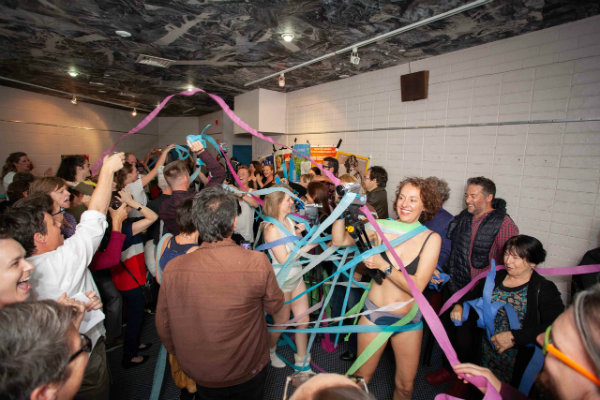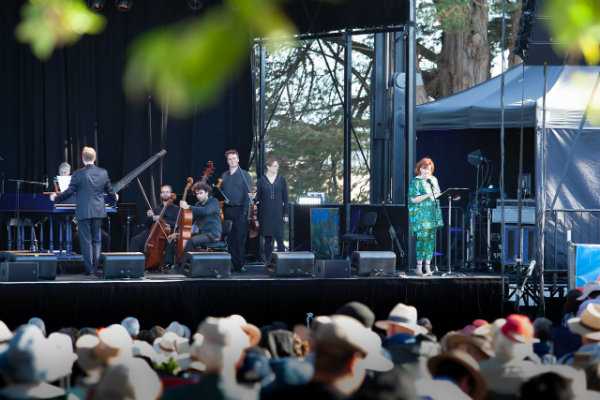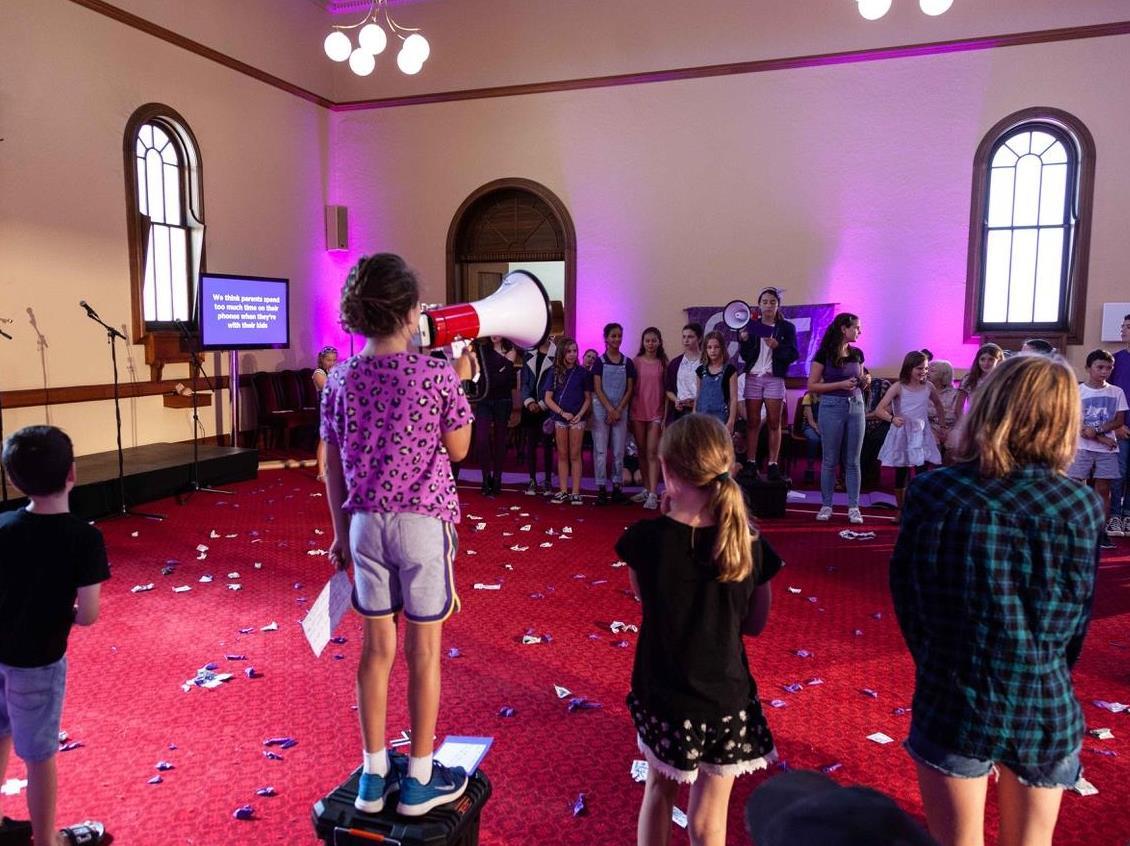Image: The Children’s Party. Photo by Sonja Ambrose.
I start my weekend in the North East of Tasmania in a dark alley, waiting to enter Launceston’s Earl Arts Centre, a small, black box theatre seating 184 people. It is situated directly behind the larger Princess Theatre, where Encore Theatre’s community production of Strictly Ballroom is currently playing. The production has sold around 8000 tickets.
I’m in the alleyway because I’m waiting to see Gob Squad – a UK/German collective whose work has been shown more than 200 times all over the world. It’s their first time in Tasmania and they are sharing a fantastical mission via a practice in which theatre, audience participation, art and media collide. Their work, Super Night Shot is billed as ‘a completely unpredictable show that elevates the everyday into the epic and plays with your perceptions of the familiar’.
Super Night Shot begins when the four performers meet, gather their video cameras and launch themselves into the city on a simultaneous mission. The audience join Gob Squad in the theatre an hour later, where the collective synchronise tapes and share the work. It’s a clever idea that has the potential to highlight the mundane and familiar in a way that prompts community reflection.
In the film, Gob Squad have designated roles – PR Rep, Performance Recruiter, Hero, and Location Scout. The work is entirely unpredictable and entirely unedited, but the structure and parameters are replicated each time.
In the early minutes of the work we are begged to support the success of the hero’s mission. Yet we don’t understand why their chosen mission is to kiss a stranger, and it’s increasingly unclear how the heroes’ journey solving community issues relates to this mission.
Something is very evident from their documentation of their mission in Launceston – not much is going on and the streets are almost empty. Gob Squad struggle to find action beyond the prosaic and people on the street don’t want to interrupt their plans to help them, which makes for somewhat disappointing, albeit amusing viewing. Here they attempt to highlight the banal in order that we can celebrate the extraordinary.
But what I’m most struck by in this work is the performers’ inability to listen to the community they are engaged with. After one of the few community members who will engage with them shares his concerns about multiple socio-economic and social pressures, they repeat the mantra, ‘It seems in Launceston that no one has any issues, life is perfect’. However, what made me most uncomfortable is a short interaction with two vulnerable young people, one who relays a story of police harassment and violence, and the other who hints at some very difficult family problems. In that moment the Gob Squad performer makes a cheap joke at the young woman’s expense and I’m left with the feeling that there is a level of unintended exploitation in the work that night that I’m not so comfortable with.

Gob Squad’s Super Night Shot. Photo credit: Sonja Ambrose.
The Ten Days North East weekend is sandwiched between Encore’s very popular season of Strictly Ballroom and the Launceston International Comedy Festival. In regional areas it can be a difficult task to draw audiences out for work if it is not part of a subscriber season or if it is by a company the community is unfamiliar with. Sometimes there are simply not enough audiences to fill multiple theatres on the same night. Ten Days on the Island came up against this very challenge in the North East and it meant some quality contemporary work such as The Children’s Party and Gob Squad fell well below sales expectations. However there were box office successes too; Women of the Island, a film offering, sold out, Peter and the Wolf with the Tasmanian Symphony had solid audiences and The Enchanted Island – Opera in the Vineyard exceeded the festival’s expectations.
Which is where I found myself on a spectacular Saturday afternoon, listening to a virtuosic suite of Baroque operatic performances featuring the Van Diemen’s Band, a Tasmanian chamber orchestra conducted by Benjamin Bayl. It is a popular event hosted by Clover Hill Winery in Lebrina.
The light of the setting sun, the champagne, the backdrop of Tasmanian pastures and gentle sounds of birds could convince anyone who’d never been to an operatic performance to try it – and that’s the point really, isn’t it?
As a first time operatic attendee, could you enjoy the music and respect it entirely because of its quality, even if you didn’t completely understand its complexity? It would be difficult, here among the trees in the setting sun, not to enjoy the performance, and hundreds of families, as well as older couples and young people do.

Opera in the Vineyards. Photo by Sonja Ambrose.
Unfortunately Launceston audiences did not support The Children’s Party in the same way, which is a lost opportunity, as it’s a fantastic piece of performance created by Alex Walker, Ben Landau and House of Muchness (a group of children from Melbourne who are Australia’s first child-led political party).
It was a joy and pleasure to see children leading this show, and perhaps even more so, it was a pleasure to see some of the adults in the audiences struggle with the idea. The two children welcoming us into the space give specific instruction as to where the audience should sit – children in the front row, adults to the back. Already one of the adults is struggling and refuses to move behind.
We are guided through The Children’s Party via a structure that would be familiar to anyone who has been through leadership courses in the last ten years, particularly the ‘get to know you and your values and your influencers’ activities. It’s basically a collaborative corporate workshop structure we’ve done many times, reimagined. I can’t help but love it, because it works brilliantly and gleans surprising and insightful results.
In the context of the recent children’s climate change strike and the school marches in the US against gun violence, it is clear children have vital and timely observations and advice about their world. There’s a lesson here in The Children’s Party about this generation; stand back let them lead, and listen to their ideas.
It was a joy and pleasure to see children leading this show, and perhaps even more so, it was a pleasure to see some of the adults in the audiences struggle with the idea.
Over the weekend I also caught two of four Intimate Epics, both created by Tasmanian artists: Crime Scene and Protecting Veil.
Staged in the Longford Town Hall, Crime Scene is a fascinating installation work full of potential. A collaboration between artists Anna Gibbs, Elizabeth Day, Julie Gough and Noelene Lucas, it plunges you deep into the heart of a difficult Tasmanian past in a unique and engaging way.
The four sides of a crime scene tent are used as a projection surface for the stories of four grisly murders. Two of them are particularly fascinating. One, via multimedia magic, reveals the inside of the tent with a crime scene processer going about their business. The other, a slow, mesmerising, continuous black and white image places you in the footsteps of another. I yearned for real human activation at times, a layered soundscape or the addition of a more guided performative invigilation on entry, elements that would have made the work more interactive and less static.
As I was driving into Longford I stopped for fuel and the servo attendant mentioned that quite a few visitors had asked where the Town Hall was. I told him about the project and he said he’d like to see it, because as Tasmanians we need to talk about the past in order to move forward. Projects like Crime Scene add to a narrative that helps bring submerged aspects of Tasmanian history to the surface.
The second Intimate Epic I see is Blue Cow Theatre’s Protecting Veil by Robert Jarman, a compact work for an audience of 25, staged in a small room upstairs in the Empire Hotel in Deloraine.
The room chosen to show the work is a complete mishmash of clashing styles. The period chandeliers, modern woodwork, deco lights and 80’s apricot curtains make it challenging to focus on the details of the work as there is so much in the environment competing with it. Focussing in is rewarding, however.
This thoughtful, intellectually thorough and charming piece is nuanced and engaging. It’s part one-man show, part performative Renaissance art history lecture; dense in metaphor and history and sensitive in its delivery. As always on stage, Jarman is beguiling and captivating as he reflects on Catholic and Anglican rituals and rites of passage. Protecting Veil played to a mixed range of audiences, some as young as eight.
Jane Haley, Ten Days on the Island CEO, tells me that it’s difficult to get the triad of pricing, programming and marketing right. In the North East there will no doubt be some conversation in the debrief as to why some of the key stars of the program didn’t reach the audience they anticipated.
Reaching and inspiring arts audiences to embrace original contemporary performance beyond their support of local musical theatre is a nationwide challenge, particularly in regional areas. Which is a shame, because the North East of Tassie missed out on some fantastically engaging and accessible contemporary performance. I hope the audiences in the South don’t make the same mistake.
Read Kath Melbourne’s overview of Ten Days on the Island’s first weekend here.





